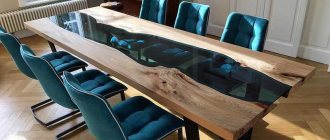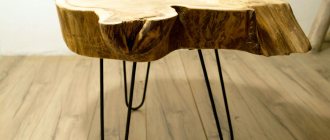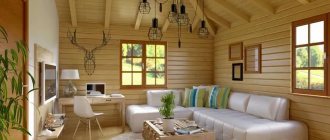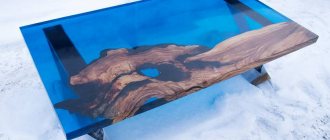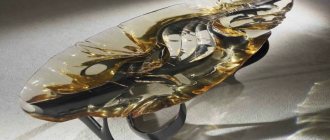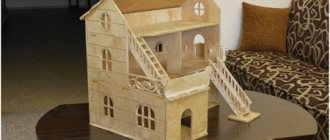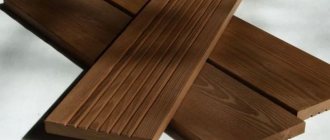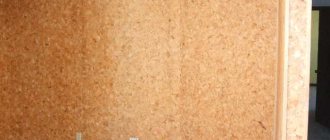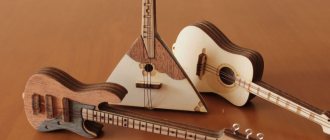Modern interior design solutions involve the use of custom-made furniture. With the help of such objects you can enliven any project and give the surrounding space a distinct character. Epoxy resin countertops have become especially popular in recent years . These elements are made only by hand, and therefore are quite expensive. But you don’t have to save up for a long time for such a table, because you can make it yourself.
We will tell you in detail how to make a table from epoxy resin with your own hands, which epoxy resin tabletop will look better in a certain apartment design.
Design and construction features
Epoxy resin tables are characterized by a unique design and can fit into any interior. Most often they are used in kitchens and living rooms, and there are no strict requirements for the style solution. Epoxy is used not only to make new products, but also to restore old furniture. Many models are made by combining several materials.
The peculiarity of the resin is that it hardly shrinks after hardening, therefore it retains its original shape for a long time. In addition, it can be decorated in different ways. Resin tables come in several types of designs:
- Combined. In this case, synthetic material alternates with wood elements.
- With the presence of support. Only the top layer is filled with resin. Additionally, various decorative elements are used: leaves, coins, flowers.
- Without the presence of support. There is only epoxy here. Small coffee tables are made this way. They are not intended for significant mechanical loads.
The product can be transparent, single-color or combined. The most commonly used are light turquoise and blue shades. Often the design is equipped with additional lighting or fluorescent powder. Handmade tables have a high cost, but such furniture can be made independently. The advantage of the process is that the cost of the model is reduced. There are other advantages: the opportunity to show imagination, restoring old furniture in an original way.
Combined
With the presence of support
Without the presence of support
Making a groove for inserting glass into the upper part of the slab
0
Source:
Once we have the glass, it's time to make grooves to install the glass so that the edges match. We attached the two halves of the slab to the table using clamps and clamped the glass into the wood. (observing the external size of the countertops)
7.
0
Source:
Using a hand router and a 10mm straight wood cutter, and using the glass as a template, we make a perfect line that matches the edge of the glass. IMPORTANT! Keep in mind that the cutter is 10 mm, which means that before clamping the glass, the slabs need to be moved apart from each other by 20 mm. After making a groove on one slab, make a groove on another slab using the same technique. Then I need to remove any remaining wood in the grooves. To do this, we use the same 10 mm cutter for wood grooves. When the entire area of the groove for inserting glass is leveled to the required depth, we check that it fits the glass.
8.
0
Source:
Once we make our final pass, we check the depth using glass to confirm this.
9.
0
Source:
After making the groove, we clean any marks left by the cutter with a scraper and sandpaper.
10.
Properties of epoxy resin
Epoxy resin is a synthetic oligomer material. It is not used in its pure form. To obtain a solid fragment, the resin must be polymerized using a hardener. Different proportions of components make it possible to create materials with different physical and mechanical properties. The resin has the following qualities:
- strength and resistance to chemicals;
- no unpleasant odor when working with epoxy;
- the polymerization process occurs at temperatures from -15 to + 80 degrees;
- slight shrinkage after hardening of the material, its stable structure;
- poor moisture permeability;
- high resistance to mechanical damage and abrasive wear;
- no need for expensive care.
When using additional protective components, such a table becomes immune to direct sunlight.
The resin also has some disadvantages: when exposed to high temperatures, it can release harmful substances. To work with the substance, you must have certain skills and fully comply with the application technology. Such material has a high cost.
Durable and chemical resistant
No unpleasant odor when working with epoxy
Minor shrinkage after hardening of the material
Weak moisture permeability
High resistance to mechanical damage and abrasive wear
No need for expensive maintenance
Product care rules
Correctly poured resin onto the countertop will create a perfectly flat surface. To extend the quality characteristics, it is necessary to treat the product with care and provide timely care. Contact with high-temperature objects must be completely avoided. You cannot place hot pots or a boiling kettle on such a table. It is guaranteed to melt.
For cleaning, you can use soapy detergents, sponges, and soft rags. Aggressive mixtures with abrasive particles should be excluded. Upon contact with them, the surface will become cloudy and lose its shine.
Popular modifications
Making a table from epoxy resin is a task for a craftsman with good imagination. In addition to standard pieces of wood, luminescent paints or powders, buttons, wine corks, moss, plant leaves, sea stones, and cobblestones can be used for decoration.
River
A special feature of the river table design with epoxy resin is that it is based on the same placement of elements: an insert made of the specified material is localized between two pieces of wood. It can be straight or follow the curves of the tree, wide or narrow, with decorative fragments, islands, and stones.
The shapes of the tabletops here are different: round, oval, rectangular. Interesting options are in which wood plays the role of a river bank, and resin plays the role of water. These products can be installed in the living room and kitchen. The model looks great in the office. With a river you can make a coffee table in Provence or country style. As for material consumption, about 13-14 kg of substance is needed for a river measuring 210 x 15 x 5 cm.
Solid surface
To create a solid table made of liquid glass, you need to use a mold of the required size. Most often, such structures are made without support and do not provide for intense loads. Tabletops of this type are used for the production of coffee tables or dressing tables. To make an epoxy resin tabletop, the dimensions of which are 100 x 60 x 5 cm, approximately 30 liters of resin are required.
From slab
Slabs are solid massive slabs of wood or stone. To make such a product at home, lighter material is taken. The tree usually represents a longitudinal cut of the trunk with remaining knots and uneven edges. This will allow you to create a unique model.
Often a slab table is made of oak. In this format you can make a kitchen surface, a structure for a living room, or an office. The thickness of the wood material ranges from 5 to 15 cm. It should not be glued or have other joints. To make a table from medium-sized epoxy resin slabs, you will need about 10 kg of the substance.
From cuts
Solid wood tables look very original and rich. Models of saw cuts of wood material coated with an epoxy solution look no less impressive. To fill such a countertop, a minimum of 7 kg of polyester substances is required. This model is perfect for kitchens, cottages in country style, eco-friendly. No matter what kind of hemp or solid trunk the cuts are made from, the design of each of them will be unique.
Tables of this type have different shapes: round, oval, rectangular and even square. The number of fragments used depends on its choice. The material must be of high quality and the required diameter. Cracked elements are not recommended to be used.
Which epoxy to choose?
If you have already decided on the type, look, and design of the future countertop, now it is important to decide on the choice of epoxy resin. Epoxy resin for pouring a countertop must be transparent and have a long life, otherwise you risk seeing the resin “boiling” with your own eyes or spending many times more time on layer-by-layer pouring. Structural and base resins (such as ED-20) are not appropriate here, because they are thicker, which will not allow all the air bubbles to escape, they are more fragile, not always colorless (grade 1), and the hardeners that are used with such resins (pepa, theta, etc.) will give you a mixture with insufficient life time, which again It can also lead to both deformation of the product during rapid curing and boiling of the mixture.
Add a description
Of the resins presented in our store, the EpoxyMaster 2.0 composition will suit you, allowing you to fill layers up to 5 cm in one layer. The composition has a low viscosity, provides good fluidity and filling of hard-to-reach areas, and moderate reactivity allows you to work with large objects. In addition, the EpoxyMaster composition has excellent self-leveling, resistance to peeling and cracking, good fillability and no “whitening” effect of the coating.
EpoxyMaster 2.0 Set for pouring in a layer up to 5 cm thick
Thanks to the transparency of the composition, you can achieve almost any visual effect: pour in various fillers (shells, dry leaves, stones, pictures, etc.), you can organize lighting both in the thickness of the tabletop and under it, you can realize a creative idea with a phosphor or color the resin, while maintaining the overall transparency of the layer.
Updating an old table with epoxy resin
Even if the table has become dilapidated over time and under the influence of negative factors, it can not only be updated, but also made into an original piece of furniture. You can use photographs, buttons or coins for decoration. The work includes the following stages:
- Elimination of rotten and damaged areas, old paint. The surface must be thoroughly dried.
- Laying decorative elements. If they are light, then it is better to glue them to the base, otherwise they may float.
- Application of resin. The procedure is repeated several times with an interval of 2-3 days.
The dried layer should be sanded and varnished. Restoring or making tables from epoxy resin is not a technologically simple process. But if you follow all the nuances of the work, you can create a real masterpiece yourself.
Sanding, painting
0
Source:
All that's left to do is some final sanding. We use grit 220 and a hand grinder. We make sure the edges are not too sharp. After sanding, remove dust from the surface. For finishing we use oil and wax for countertops. It's a simple application, use a cotton rag to apply, let dry for a few hours, lightly sand with 320 grit (only after the first time) and repeat this process three or more times.
23.
Advantages of natural furniture
The choice in favor of natural furniture is due to several reasons:
- Wood does not pose a risk to human health. Furniture based on it does not emit toxic substances and is suitable for people suffering from allergic reactions.
- Calm colors have a positive effect on the emotional and mental state and improve the atmosphere in the house.
- Timber products have a long service life. Wooden furniture has good wear resistance. The products are practically not subject to rotting.
- Each cut has a unique natural pattern. Graceful carving gives the cladding originality. In most cases, wood fits well into any interior style.
- This criterion is relevant only when making furniture yourself. The purchased option belongs to the expensive segment.
A table made of natural wood fits perfectly into the eco-friendly interior
Working conditions
It is necessary to work with resin in a dry (very important!) and warm , well-ventilated room. High air humidity can have a critical effect on the surface of the finished product after hardening. It is highly recommended to use personal protective equipment when working with resin: respirator mask, gloves, safety glasses. We also recommend using work clothes - it is very easy to get dirty with resin, and it is almost impossible to wash it off the fabric.
We offer the following range of protective equipment:
- Not available
Rating 5.00 out of 5
Set of nitrile gloves
From 160 rub. More details
- Disposable polyethylene protective apron
From 60 rub. Choose …
- Open safety glasses
180 rub. Add to cart
- Disposable polyethylene sleeves
From 75 rub. Choose …
- Respirator Jeta Safety J-SET 6500
3358 rub. Choose …
- Respirator Jeta Safety J-SET 5500
3218 rub. Choose …
